To put it simply, marketing is everything you do to find and be found by potential customers. Whether you’re a real estate agent or a small business owner, understanding digital marketing and how to promote your brand is essential. Thankfully, in this article we’ll explain everything you need to know about digital marketing so you can get started ASAP.
What is Digital Marketing?
Digital marketing is an umbrella term for any type of online marketing or advertising. Some common elements of digital marketing include:
- Search Engine Optimization (SEO).
- Paid Search.
- Display or Banner Advertising.
- Remarketing or Retargeting.
- Email Marketing.
- Social Media Marketing.
- Social Media Advertising.
- Content or Inbound Marketing.
(You’ll notice “website” didn’t make the list. That’s because your website isn’t a form of marketing. Online marketing activities that drive traffic to your website and generate leads is the actual digital marketing we’ll discuss here.)
Search Engine Optimization (SEO)
Search engine optimization is a digital marketing strategy to help your website be found in the search engines (like Google). In other words, SEO efforts should boost the visibility of a website.
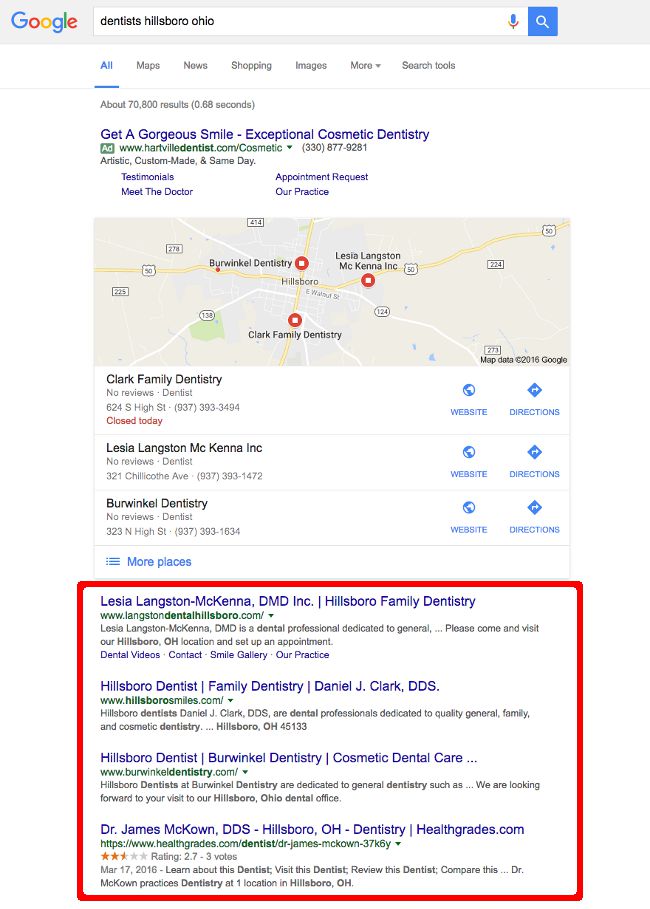
The “organic” section of Google’s search results page
SEO directly affects how high your site will appear in the organic section of a search results page (SERP). (Note, in this instance, “organic” refers to non-paid search results.) The average user will not click past the first two pages of search results. In fact, the top three search results on any given page attract 75% of all user traffic. So the higher your site appears, the more likely potential customers are to find your website.
Businesses that show up on page one may exist in a market or location that has little competition. Alternatively, they may also reach high ranking status by actively engaging in search engine optimization practices in-house or by using an outside firm.
Search engine optimization doesn’t produce instant results. Rather, it’s a long-term strategy designed to produce lasting results over time. It can take months for an SEO strategy to start generating traffic. However, if your business doesn’t prioritize this practice now, it may prove difficult to rank for important keywords or phrases relevant to your industry or brand.
Local SEO
In addition to the above, local businesses like attorneys, dentists and physicians, plumbers, roofers, and other home improvement contractors must focus on connecting with local consumers.
The goal of local search or local SEO is to ensure your business appears in both the local section of the search results (below) and on the top local directories and review sites.
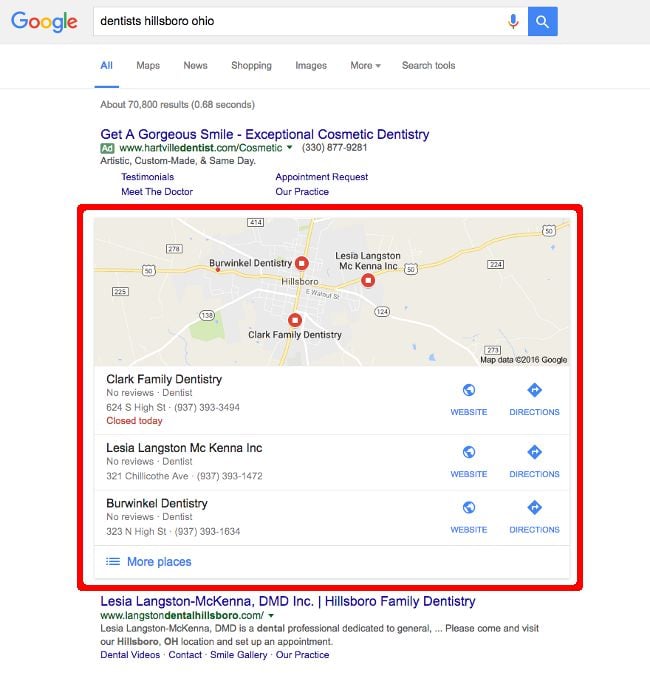
Google’s Local section of the search results page
{{cta(‘ba433449-3839-45a2-9da9-3e32ac3de022’)}}
Paid Search
Paid search (a.k.a., search engine marketing or SEM) involves purchasing ads on the top, bottom, and right side of the search engine results pages.
Whenever someone uses search words or phrases related to your product or service, your ad may appear. Companies can do this by purchasing ads related to specific keywords and phrases. (See example below.)

Google places paid ads at the top and bottom of its search results page
Paid search is commonly referred to as pay-per-click advertising (PPC) because you only pay when someone clicks on your ad. This makes PPC an incredibly efficient way to attract customers. But at the same time, it’s also imperative to create PPC ads that entice qualified leads only. Otherwise, you could end up spending a lot of money on prospects that aren’t in your target market or region. A real estate agent in Milwaukee has little use for leads looking for a home in St. Louis, for example.
Google Ads (formerly AdWords) is the best-known type of pay-per-click advertising. Google Ads allows businesses to display ads on Google’s search results page and its network of partner sites.
Unlike SEO, pay-per-click advertising can be used as a short-term strategy to produce instant results. Still, like any type of advertising, you must continue to pay to keep your ad running, and PPC ads often require regular maintenance and tinkering to produce the best results possible.
Display or Banner Advertising
Display advertising allows you to advertise over a wide variety of websites by placing your banner ads on the top and sides of the main content.
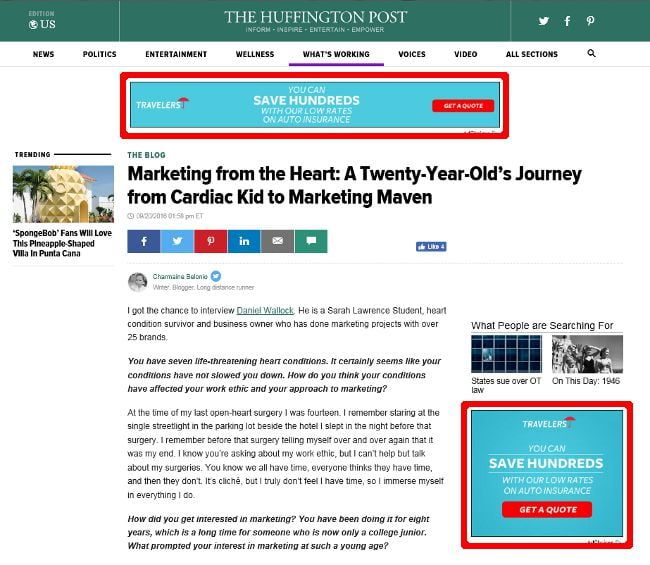
With display advertising, you can reach your target audience by geography (city/town, county, or zip code), demographic (age, income, gender, etc.), behavior (people who’ve recently searched for your product or service), or any combination thereof.
Click-through rates on banner ads are extremely low—0.17% (less than 2 clicks per 1000 impressions). So it’s best used for building brand awareness rather than generating leads.
That said, there are new types of display advertising that match a computer IP address to a physical address, allowing you to send an online banner ad and a direct mail piece to the same household or business.
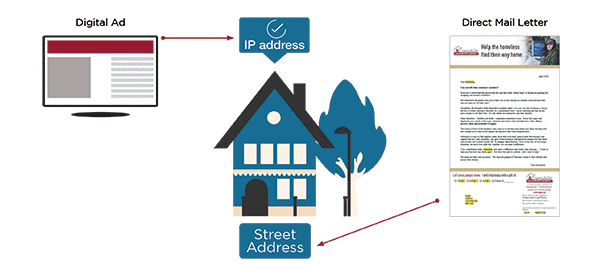
These IP-targeted campaigns have an average click-through rate 3.2 times higher than industry averages. Data from hundreds of thousands of IP-targeted campaigns show that combining IP targeting with direct mail increases response rates an average of 30 percent.
Remarketing or Retargeting
Retargeting is an advertising strategy designed to re-engage visitors who have left your website without taking action.
Ninety-eight percent (98%) of visitors leave a website without contacting the business or making a purchase. What’s more, it usually takes several points of contact before a lead makes a purchase decision. Retargeting increases return visits to your site by continuing to market to them throughout their buying process.
Here’s How it works:
- A consumer visits your website and views your offer.
- Visitor leaves without taking action.
- As he or she visits other websites within the ad network, your display ad appears on the top or along the side of the page.
- The consumer sees your ad, is reminded of their previous interest, and has the opportunity to return to your site.

According to a study conducted by SeeWhy, 26% of customers who are exposed to retargeting will return to the website. Without retargeting, only 8% return.
Email Marketing
Not to be confused with SPAM, legitimate email marketing is based on getting permission from people who are interested in hearing from you. This could be existing customers or people who have inquired about your product or service by filling out a contact form on your website.
Think email marketing isn’t effective? According to the Direct Marketing Association, it yields an estimated 4,300% return on investment (ROI).
Here are some other compelling stats to consider:
- 44% of email recipients made at least one purchase last year based on a promotional email (Convinceandconvert.com)
- 55% of companies generate more than 10 percent of sales from email (Econsultancy/Adestra Email Marketing Census)
- 42% of businesses say email is one of their most effective lead generation channels (Circle Research)
Because it’s mostly free, email marketing is the most abused form of marketing. Those that misuse it could end up on a SPAM blacklist, which can prevent legitimate emails to existing customers and vendors from getting delivered. Given that fact, it’s important for marketers to curate their lead list on a regular basis. Not only will this allow you to only focus on leads that are interested in your product or service, but it will prevent your emails from getting tagged as SPAM. It may seem counterintuitive to purge leads from an email list, but if they haven’t responded to your emails over a long period of time, it may be in both of your interests to do so.
{{cta(‘0b6d2263-1cb5-41f7-a1dd-04a38dffcd75’)}}
Social Media Marketing (SMM)
Social media marketing is the process of using social media to generate website traffic and leads by draw attention to your business.
The goal of social media marketing is to post content that users will share with their social network to help your company increase brand exposure and broaden its customer reach.
Top Social Media Sites
- Facebook (2.7B users).
- YouTube (2B users).
- WhatsApp (2B users).
- Instagram (1.2B users).
- LinkedIn (675M users)
- Reddit (430 M users).
- Twitter (353 M users).
- Snapchat (200M users)
- Pinterest (100M users)
Although social media has been touted as a “free” way to market, small businesses often struggle with choosing the best social media channels, finding time to post consistently, generating leads, and growing their follower base.
Keep in mind that Facebook is by far the most visited and used social media site in the world. So while certain businesses may find success advertising on other sites, Facebook really does dominate this practice.
{{cta(‘16976b31-9d43-4439-a232-608c0e062f4f’)}}
The Decline of Organic Reach
Many social sites—Facebook in particular—have decreased the organic reach of user posts (Organic reach refers to how many people you can reach for free by posting to your page.)
At one point, businesses on Facebook could reach roughly 16% of their followers through an organic post. Now in 2020, the average reach of an organic post is a mere 5%. This means over 95% of your Facebook fans don’t see your posts.
Depending on who you ask, there are two possible explanations for this:
- There’s simply too much content and Facebook wants to provide the best user experience by not cluttering the News Feed with too many business posts.
- It’s Facebook’s way to get people to spend money on ads.
The reality is social media companies need to make money and become profitable just like any other business. As a result, social media has evolved into a paid marketing channel. (You didn’t expect to get all that exposure for free, did you?)
That’s not to say it’s impossible to get a higher than average organic reach. It’s just a lot more difficult.
Social Media Advertising
It’s not all bad, and that’s mostly because social media advertising is such an effective marketing tool. Indeed, half of all consumers admit to clicking on ads they see on social media.
You can reach people who haven’t followed or liked your Page by targeting by location, demographics, interests, or behaviors.
But the nature of Facebook offers some unique targeting options not available in other forms of advertising:
- Connections targets people and their friends who already like your Page.
- Custom Audiences targets existing customers or website visitors, using a customer contact list, your website traffic, or activity in your app.
- Lookalike Audiences targets people similar to your best customers.
You also have a variety of ad types to choose from, such as:
- Special Offers to entice more people to do business with you
- Events to invite people an open house or seminar
- Local Awareness to reach people surrounding your business
- Lead Capture Ads that allow people to sign up for your offer in exchange for their contact information
Carousel Ads
Facebook’s newest ad format is the Carousel Ad which allows you to showcase multiple products within a single ad.
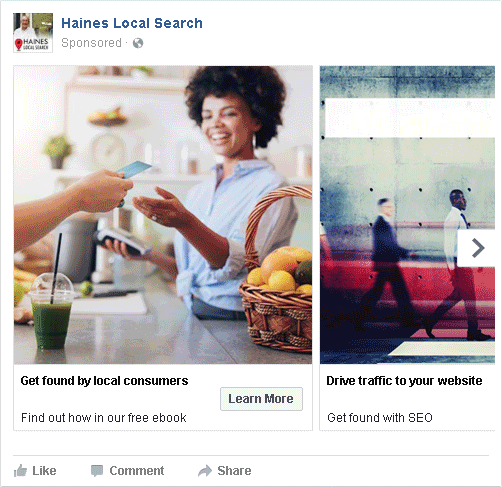
According to case studies, carousel ads are driving more traffic and getting higher click-through rates than static sponsored posts.
{{cta(‘050a75bb-5518-4c64-923f-ff68e1a11e4b’)}}
Unlike paid search, Facebook targets people by their interests rather than their search phrases. In other words, you’re targeting people based on who they are rather than what they’re looking for.
This lets you reach people early in the buying process, before they are fully aware of their need or don’t realize they need what you have to offer.
Content Marketing or Inbound Marketing
Content marketing attracts potential customers to your website by providing articles, videos, pillar pages, and ebooks that address a problem or question they have.
Content marketing and inbound marketing are often used interchangeably, but there’s an important difference.
Inbound marketing elevates regular content marketing, by offering more in-depth information on the same topic that brought the visitor to your website — like an ebook that requires they fill out a contact form to obtain the info.
This turns a visitor into a potential lead. Now you can interact with them each step of the buying process, by offering valuable content to help them along the path to making a decision.
 So to sum it up, content marketing is a subset of the entire inbound marketing methodology, which turns visitors into leads, then nurtures those leads into customers.
So to sum it up, content marketing is a subset of the entire inbound marketing methodology, which turns visitors into leads, then nurtures those leads into customers.
The Final Word
The myriad of digital marketing choices doesn’t need to be overwhelming. If you’re just starting out, consider email marketing, social media marketing and social media advertising.
For those with a larger budget, adding search engine optimization and inbound marketing to the above is an effective combination.
If you need to generate leads immediately, paid search, display advertising, and retargeting make a powerful advertising trio. And of course, our team at Haines is always standing by to offer you marketing and advertising advice and support. Our services are designed to help you stay in touch with important contacts in your area. Contact us here for more information.












